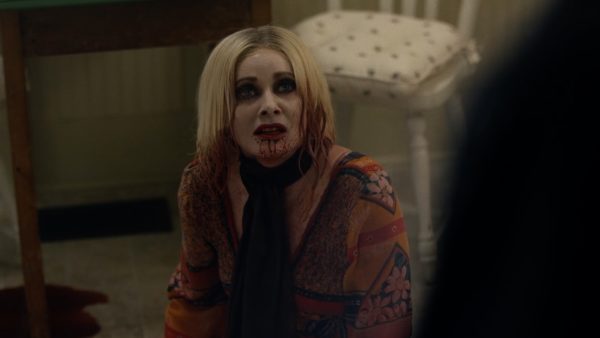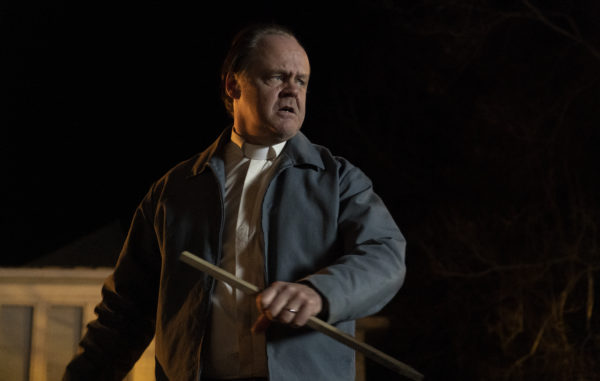
Two genre vets and a hot director team up for a fresh take on vampires. So why is Jakob’s Wife so muddled?
Jakob’s Wife opens with Jakob (Larry Fessenden), a Minister of a dying small town, and his wife Anne (Barbara Crampton) questioning young parishioner Amelia (Nyeisha Bell) about her sick mother. Amelia thanks them, then walks home through the empty, desolate town, before she is attacked on her front steps.
This opening is the perfect encapsulation of Travis Stevens’ latest horror film, which mixes the ennui of rote small town lives with a vampire story. Later in the film, when the bodies have begun to pile up, Jakob and Anne speculate that the Master (Bonnie Aarons) has set up shop in their town precisely because it is on the verge of economic collapse. There are plenty of places for an otherworldly menace to hide in the abandoned factories and mills…the issue are the pesky neighbours and church-goers hellbent on keeping tabs on one another.
It’s not a spoiler to reveal that it’s not long before Anne is seduced (not once, but twice) into an extramarital tryst. The first is with Tom Low (Robert Rusler), a College fling who arrives in town to size-up the mill. The second is with the Master, who takes advantage of Anne and Tom’s ill-timed make-out to make a meal of the latter and turn the former into a bloodthirsty vampire. And therein begins the fun: the Minister’s bored, put-upon housewife must now figure out how to adjust to her new urges without imploding her marriage.

Jakob’s Wife is a less successful take on the same logline as Netflix’s Santa Clarita Diet. Both texts are concerned with marriage as an institution: something that takes work and energy, but is not easily given up, even when domestic life turns into a series of homicidal clean-ups.
The difference is that while both Santa Clarita Diet and Jakob’s Wife have incredibly game leading ladies ripping off victims’ heads during bouts of bloodlust, the Netflix series did its own share of work to ensure that it was clear why Sheila and Joel’s marriage was worth fighting for.
Comparatively in Jakob’s Wife, Anne is bored and disinterested in her life and marriage to Jakob from the jump. Early in the film Anne tries on a shade of lipstick, then decides against it and wipes it off – the insinuation being that it’s too provocative and ostentatious. There are multiple scenes that confirm that Jakob doesn’t appreciate or value his wife: he expects meals at certain times, he speaks over her and he doesn’t listen to her opinions.
Naturally when Anne becomes a super-powered vampire, the power dynamic changes. Suddenly she’s ordering her own meal, and she’s out at all hours of the day and night while he fends for himself at home, etc.

Had Jakob’s Wife stayed in this sandbox and truly investigated the lengths this middle-aged, well-off religious couple go to keep their marriage afloat, it could have been solidly compelling. And indeed, watching established pros like Fessenden and Crampton interact is entertaining.
But Stevens’ script, co-written with Kathy Charles and Mark Steensland, is never willing to let the performers off the chain and fully embrace the horror comedy potential of the situation. Anne’s realization of her newfound powers is demonstrated not by an orgy of violence or a delirious off-kilter sequence, but with a low-key (verging on bland) montage of her moving furniture around. It represents the limits of Anne’s stilted imagination after years of repression by Jakob that when she’s given powers the most she can fathom to do with them is become her own interior decorator…but it also feels like a missed opportunity.
Unfortunately Jakob’s Wife is filled with them. At one point Jakob denounces the Master and, determined to return his marriage to what it was before, he and Anne go to the mill. It’s set up to be a major showdown. Once there, however, Jakob changes his mind and the couple simply return home.
In this way the film is at odds with itself. Is it interested in exploring how Jakob and Anne address the new problems in their relationship (ie: that she will routinely eat a neighbour or two) or is it a conventional vampire hunting film? The answer is, sadly, both. This results in a plot that lurches about in fits and starts, particularly in the saggy second act when the two plotlines vy for domination.

Alas the film is unwilling to commit to what story it wants to tell. Jakob’s Wife is unwilling to do the work of clarifying why Anne stays with Jakob after she’s turned, or even what’s so great about being a vampire (she claims it has freed her, but the script equates this with a wardrobe consisting of scarves and a loss of meekness). Meanwhile, aside from Aarons’ intriguingly genderqueer flipped casting, the vampire lore side of the film is all fairly rote and familiar.
Overall Jakob’s Wife is fine: it has inspired moments of comedy courtesy of genre vets, as well as great gore and plenty of horrific imagery. Anything involving Anne’s teeth and mouth, particularly the teeth whitening scene, is a stand-out.
The film is at its best when it focuses on the middle-aged couple going through a rocky stage of their marriage that just so happens to involve vampirism. Alas Jakob’s Wife keeps getting distracted by its adherence to genre elements, which prevents the film from fully investing in what makes Anne and Jakob’s relationship work.
And if the film doesn’t fully commit, then how can we?
3/5
Jakob’s Wife is now available On Demand and Digital